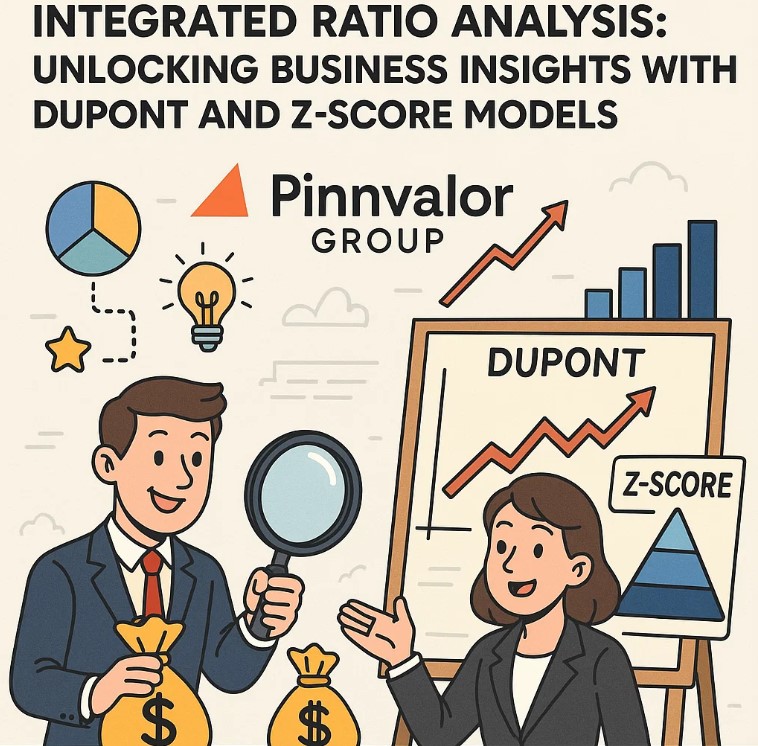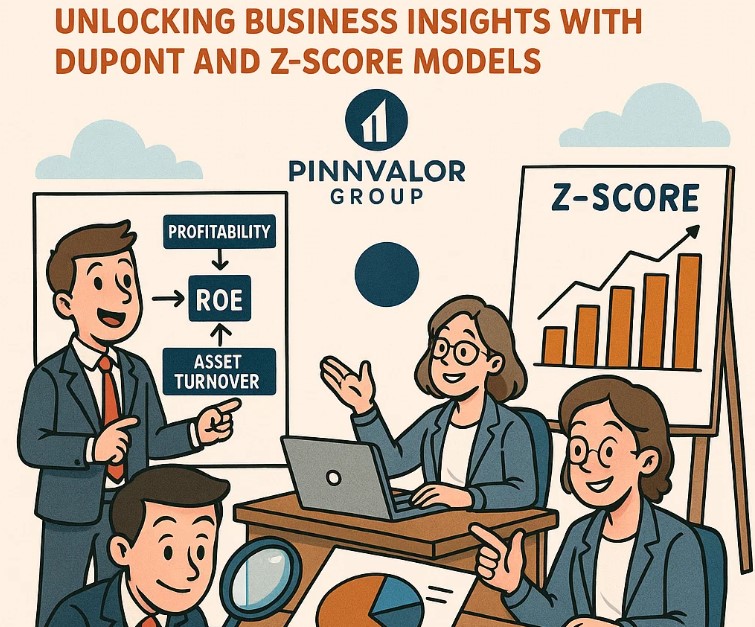
Integrated Ratio Analysis: Unlocking Business Insights with DuPont and Z-Score Models
In the ever-evolving world of finance, understanding a company’s true health requires more than just a glance at a few numbers. Financial ratios have long been a fundamental tool for assessing a company’s performance, efficiency, and risk profile. However, isolated ratios often fail to capture the full picture. That’s where Integrated Ratio Analysis comes into play, combining powerful models like the DuPont Analysis and the Altman Z-Score Model to provide a holistic view of business performance and financial stability.
In this blog, we will explore how these two models complement each other, and how integrating them can empower investors, managers, and analysts to make smarter decisions.
How do top investors balance growth and risk using integrated ratio analysis?
Standalone ratios only tell part of the story — integration reveals the full picture. Master the art of decoding profitability and bankruptcy risk together for smarter decisions.
What is Integrated Ratio Analysis?
Integrated Ratio Analysis involves using multiple ratio-based frameworks together to gain deeper insights into a company’s financial health. Instead of analyzing profitability, efficiency, and risk in isolation, integrated analysis synthesizes these factors to provide a comprehensive evaluation.
The DuPont Analysis and Altman Z-Score Model are two of the most widely respected tools in this domain, each focusing on different but interrelated dimensions of financial health.
Understanding DuPont Analysis: Breaking Down Profitability
The DuPont Analysis is a technique that breaks down Return on Equity (ROE) into its component parts, enabling a detailed examination of what drives a company’s profitability. ROE measures how effectively a company uses shareholders’ equity to generate profits.
The DuPont formula expresses ROE as the product of three key ratios:
ROE = Profit Margin × Asset Turnover × Financial Leverage
- Profit Margin (Net Income / Sales): Shows how much profit the company makes on each dollar of sales.
- Asset Turnover (Sales / Total Assets): Measures how efficiently the company uses its assets to generate revenue.
- Financial Leverage (Total Assets / Shareholders' Equity): Indicates the extent to which the company uses debt financing to amplify returns.
Why is DuPont Analysis Useful?
By dissecting ROE, the DuPont Analysis helps identify whether profitability changes arise from operational efficiency, asset management, or capital structure. For example:
- A declining profit margin may indicate rising costs or pricing pressure.
- A low asset turnover might signal inefficient use of assets.
- High financial leverage can boost ROE but increase financial risk.
This granular insight allows management to focus on specific areas for improvement.
Exploring the Altman Z-Score Model: Assessing Bankruptcy Risk
While DuPont focuses on profitability and efficiency, the Altman Z-Score Model specializes in assessing financial distress risk. Developed by Edward Altman in 1968, the Z-Score predicts the likelihood that a company will go bankrupt within the next two years.
The model combines five financial ratios weighted by coefficients into a single score:
Z = 1.2 × (Working Capital / Total Assets) + 1.4 × (Retained Earnings / Total Assets) + 3.3 × (EBIT / Total Assets) + 0.6 × (Market Value of Equity / Total Liabilities) + 1.0 × (Sales / Total Assets)
Based on the calculated score:
- Z > 2.99: “Safe” zone – low bankruptcy risk.
- 1.81 < Z < 2.99: “Grey” zone – some risk.
- Z < 1.81: “Distress” zone – high risk of bankruptcy.

Importance of the Z-Score
The Z-Score offers early warning signals of financial distress by evaluating liquidity, profitability, leverage, and market valuation. It’s widely used by lenders, investors, and creditors to assess creditworthiness and investment risk.
Why Integrate DuPont and Z-Score Analysis?
While DuPont analysis uncovers the drivers of profitability and operational efficiency, the Altman Z-Score evaluates the financial viability and default risk. When used together, they provide a balanced perspective on both growth potential and financial safety.
Benefits of Integration
- Holistic View: Understand not just how profitable a company is, but also how sustainable that profitability is given the financial risk.
- Balanced Decision-Making: Avoid pitfalls of focusing solely on ROE or profitability without considering bankruptcy risk.
- Risk-Adjusted Performance: Identify companies that may have high ROE but are at risk due to excessive leverage.
- Early Detection: Combine operational insights with financial risk to catch red flags early.
For example, a company may show strong ROE driven by high leverage (financial leverage component in DuPont), but a low Z-Score may warn that this leverage is unsustainable, signaling risk ahead.
Practical Applications of Integrated Ratio Analysis
- For Investors: Investors can use integrated analysis to select companies with robust profitability and manageable financial risk, optimizing their portfolio’s risk-return profile.
- For Managers: Management teams can pinpoint operational inefficiencies or risky capital structures and take corrective actions to enhance performance and stability.
- For Creditors: Lenders and creditors can make better credit decisions by combining profitability assessment with bankruptcy prediction, reducing default exposure.
Case Study: Integrated Ratio Analysis in Action
| Metric | Value |
|---|---|
| Net Income | $5 million |
| Sales | $50 million |
| Total Assets | $100 million |
| Shareholders’ Equity | $40 million |
| Working Capital | $10 million |
| Retained Earnings | $30 million |
| EBIT | $8 million |
| Market Value of Equity | $60 million |
| Total Liabilities | $60 million |
Step 1: Calculate DuPont ROE
- Profit Margin = 5 / 50 = 10%
- Asset Turnover = 50 / 100 = 0.5
- Financial Leverage = 100 / 40 = 2.5
ROE = 10% × 0.5 × 2.5 = 12.5%
Step 2: Calculate Z-Score
- Working Capital / Total Assets = 10 / 100 = 0.10
- Retained Earnings / Total Assets = 30 / 100 = 0.30
- EBIT / Total Assets = 8 / 100 = 0.08
- Market Value of Equity / Total Liabilities = 60 / 60 = 1.0
- Sales / Total Assets = 50 / 100 = 0.5
Z = 1.2(0.10) + 1.4(0.30) + 3.3(0.08) + 0.6(1.0) + 1.0(0.5)
= 0.12 + 0.42 + 0.264 + 0.6 + 0.5 = 1.904
Z-Score of 1.904 places Company A in the “Grey Zone,” indicating some financial risk despite a decent ROE of 12.5%.
Conclusion
Integrated Ratio Analysis, leveraging the strengths of both DuPont and Altman Z-Score models, offers a powerful framework to unlock deep business insights. This approach not only reveals how profit is generated but also assesses the sustainability and risk behind the numbers.
Incorporating integrated ratio analysis into financial decision-making empowers investors, managers, and creditors to balance growth ambitions with prudent risk management — ultimately driving smarter, more resilient business strategies.
